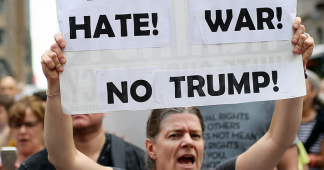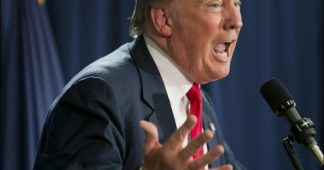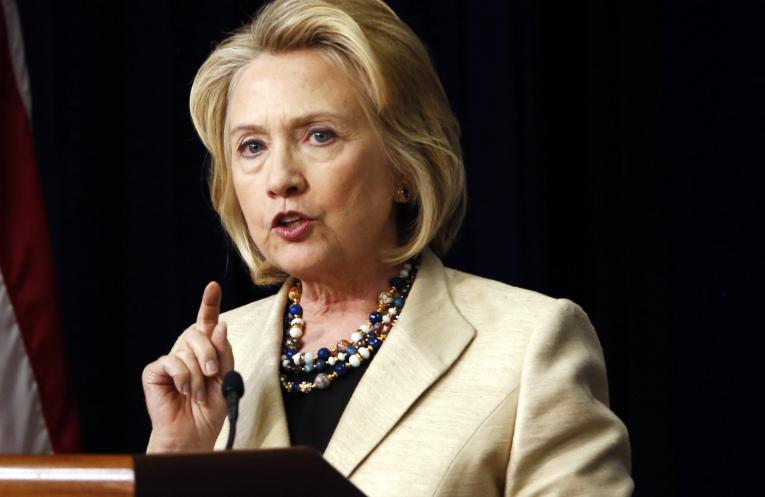The duopoly succumbed to the war machine, while organized resistance got pushed to the fringe.
By Daniel Martin
Global Research, December 28, 2017
“Imagine there’s no heaven…and no religion too.”
A more useful line when it comes to our current wars may be “Imagine there’s no duopoly.” It’s hard to fault John Lennon for his idealism, of course. In his day, many blamed religion on the wars of history. But a much bigger obstacle right now, at least in the U.S., is partisanship. The two major political parties, in power and out, have been so co-opted by the war machine that any modern anti-war movement has been completely subsumed and marginalized—even as American troops and killer drones continue to operate in or near combat zones all over the world.
Aside from the very early days of the Iraq war, the anti-war movement has been a small, ineffectual pinprick on the post-9/11 landscape. A less generous assessment is that it’s been a bust. After liberals helped elect the “anti-war” Barack Obama, the movement all but disappeared, even though the wars did not. By putting a Nobel Peace Prize-winning Democratic face on his inherited wars, Obama expanded into new conflicts (Libya, Syria, Yemen) with little resistance, ultimately bombing seven different countries during his tenure. By 2013, Code Pink founder Medea Benjamin lamented, “We’ve been protesting Obama’s foreign policy for years now, but we can’t get the same numbers because the people who would’ve been yelling and screaming about this stuff under Bush are quiet under Obama.”
It’s easy to blame the military-industrial complex, the corporate media, and the greed and malleability of politicians. But what about the anti-war movement itself? Why has it failed so miserably, and can it revive as President Donald Trump continues the wars of his predecessors and threatens new ones?
The rallies and protests in the early 2000s attracted significant numbers but they were weighed down by far-left organizations like the Workers World Party, which brought with them myriad other issues beyond war like global warming and poverty. There was also long-held and fairly broad skepticism about the intentions of United For Peace and Justice (UFPJ) and the A.N.S.W.E.R. Coalition, which organized most of the big protests over the last 17 years. This was due to the “big tent” affiliations of some of their steering committee members, which critics say led to a dilution of the message and drove the anti-war movement further from the mainstream.
Perhaps the movement’s biggest weakness was that it shied away from directly attacking its own—the liberal Democrats who voted for the war in Congress.
In a sense, Democrats did emerge as the de facto anti-war party during the Iraq war, but that was only because a Republican—George W. Bush—was commander-in-chief. And what of the Democrats who voted for the war and continued to fund it? Out of 77 senators who supported the resolution authorizing military force against Iraq in 2002, 20 are still in office and roughly half are Democrats, while out of the 296 votes in favor in the House, 90 are still in office and 57 of them are Democrats. Some of them, like Harry Reid and Chuck Schumer, went on to become party leaders. Two others, John Kerry and Hillary Clinton, went on to become secretaries of state and their party’s nominees for president in 2004 and 2016 respectively. All went on to support new military interventions and regime changes, albeit under a new, liberal interventionist, Democratic banner.
Conversely, steadfast non-interventionist Democrat Dennis Kucinich, who voted against the resolution, failed badly in both his 2004 and 2008 attempts at his party’s presidential nomination. Bottom line: Support for the war was hardly a deal-breaker for voters, any more than opposition to it was a dealmaker.
Reaction to war is just a microcosm of the political landscape, a manifestation of partisan-driven, short-term memory. Sure there might have been momentary disapproval, but when it came time to decide whether supporters of the war stayed or went, the sins of one’s party leaders meant very little in the zero-sum game of electoral politics. Parties outside the duopoly be damned.
The same thing happened to the anti-war right, as the Ron Paul movement took off in 2008 with an immense level of grassroots energy. One of the singular successes of his movement was the ability to reach people on an intellectual and practical level about the folly of our foreign interventions and the waste, fraud, and abuse of tax dollars. Paul didn’t shy from criticizing his own party’s leaders and actions. He explained the Federal Reserve’s relationship to the monetary costs of war.
Ultimately, media blackouts and distortion of Paul’s message (for example, conflating his non-interventionist foreign policy views with “isolationism”) helped kill his campaign. After Paul’s 2008 defeat, conservative political activists seized upon the Texas congressman’s libertarian-leaning revolutionary momentum and channeled it into the Tea Party—while leaving the non-interventionist impulses behind. By 2011, national coordinator Jenny Beth Martin acknowledged,
“On foreign policy probably the majority [of Tea Party Patriots] are more like [hawks] Michele Bachmann or Newt Gingrich.”
And don’t underestimate how the escalation of drone warfare during the Obama presidency muted the anti-war effort. Drone attacks made fewer headlines because they supposedly caused less collateral damage and kept U.S. troops out of harm’s way, which was portrayed by administration officials and the war establishment in Washington as progress.
What the drone program did, in essence, was to create the illusion of “less war.” Nevertheless, studies showing an increase of terrorism since the beginning of the “war on terror” indicate precisely the opposite: Civilian drone deaths (not always reported) create more enemies, meaning more of our troops will be put in harm’s way eventually.
So where should the anti-war movement go from here? Perhaps it should begin by tempering its far-left impulses and embracing its allies on the right who have been made to feel unwelcome. They could take a lesson from right-leaning places like Antiwar.com and TAC that have long been open to writers and activists on the left.
Meanwhile, flying “Resist Trump” signs at rallies not only misses the mark by suggesting that our needless wars aren’t a bipartisan, systemic problem, but creates a non-inclusive atmosphere for anti-war Trump voters. Ironically, not much “resistance” was heard when Democrats recently helped pass Trump’s $700 billion 2018 National Defense Authorization Act (NDAA) and failed to repeal the original post-9/11 Authorization for Use of Military Force, as was advocated for by Senator Rand Paul this year.
In addition, the few on the anti-war left who oppose war based on pacifist or religious reasons need to acknowledge that the majority of Americans believe in a strong national defense as outlined in the Constitution. Most people are willing to accept that there’s a big difference between that and the terrible waste and tragedy that comes with waging unnecessary wars overseas.
They are also averse to their lawmakers doing favors for special interests. Focusing on the money and influence that giant defense contractors like Lockheed Martin and Boeing have on Capitol Hill—essentially making war a business—makes the anti-war point by raising the issue of crony capitalism and the cozy relationship between politicians and big business, which increasingly leaves the American public out of the equation.
These corporations, along with Raytheon and Northrop Grumman, have accounted for $42 million in contributions to congressional candidates since 2009, with $12 million in the 2016 cycle alone. The majority of these funds have targeted Armed Services Committee members, such as perennial war hawk John McCain. In addition, influential neoconservative think tanks have received millions in grants over the years from “philanthropic” organizations such as the Bradley Foundation and the Olin Foundation, which have corporate backgrounds in the defense industry. The conservative Heritage Foundation is reportedly considering the vice president of Lockheed as its new president.
Furthermore, mantras and slogans like, “you’re either with us or against us” and “support our troops” have been used as powerful psy-ops to create a false dichotomy: you either support the war policy or you’re not patriotic. Debunking this by pointing out how these wars profit the elite while serving as a pipeline that puts more American military servicemembers—often from working-class backgrounds—into harm’s way should appeal to the current populist spirit on both sides of the political fence. In fact, it could begin to draw new, disenchanted voters into the movement.
Americans today are tired of war, which is good, for now. Unfortunately, without a strong anti-war movement, there won’t be much resistance when the next “big threat” comes along. The two major parties have proven to be false friends when it comes to opposing war—they only do it when it suits them politically. Moving beyond them and becoming stronger with allies and numbers—imagine, there’s no parties—is the best way to build a real opposition.
* Daniel Martin is an anti-war activist, musician, and rock journalist from Lancaster, Pennsylvania. Follow him on Twitter @MartysInvasion.











